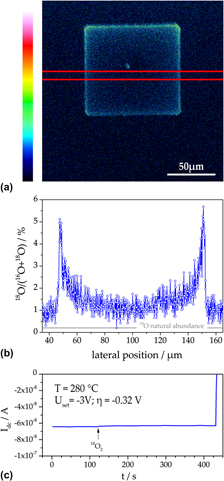Crossref Citations
This article has been cited by the following publications. This list is generated based on data provided by
Crossref.
Huber, T.M.
Opitz, A.K.
Kubicek, M.
Hutter, H.
and
Fleig, J.
2014.
Temperature gradients in microelectrode measurements: Relevance and solutions for studies of SOFC electrode materials.
Solid State Ionics,
Vol. 268,
Issue. ,
p.
82.
Nenning, Andreas
Navickas, Edvinas
Velicsanyi, Peter
Opitz, Alexander K.
Hutter, Herbert
and
Fleig, Jürgen
2015.
Mapping electrochemically driven gas exchange of mixed conducting SrTi0.7Fe0.3O3−δ and Ce0.8Gd0.2O1.9 thin films by 18O tracer incorporation under reducing atmosphere.
Solid State Ionics,
Vol. 273,
Issue. ,
p.
25.
Huber, T. M.
Kubicek, M.
Opitz, A. K.
and
Fleig, J.
2015.
The Relevance of Different Oxygen Reduction Pathways of La0.8Sr0.2MnO3(LSM) Thin Film Model Electrodes.
Journal of The Electrochemical Society,
Vol. 162,
Issue. 3,
p.
F229.
Huber, T.M.
Opitz, A.K.
and
Fleig, J.
2015.
Oxygen reduction via grain boundary transport in thin film platinum electrodes on yttria stabilized zirconia.
Solid State Ionics,
Vol. 273,
Issue. ,
p.
8.
Thalinger, Ramona
Opitz, Alexander K.
Kogler, Sandra
Heggen, Marc
Stroppa, Daniel
Schmidmair, Daniela
Tappert, Ralf
Fleig, Jürgen
Klötzer, Bernhard
and
Penner, Simon
2015.
Water-Gas Shift and Methane Reactivity on Reducible Perovskite-Type Oxides.
The Journal of Physical Chemistry C,
Vol. 119,
Issue. 21,
p.
11739.
Huber, Tobias M.
Navickas, Edvinas
Friedbacher, Gernot
Hutter, Herbert
and
Fleig, Jürgen
2015.
Apparent Oxygen Uphill Diffusion in La0.8Sr0.2MnO3 Thin Films upon Cathodic Polarization.
ChemElectroChem,
Vol. 2,
Issue. 10,
p.
1487.
Navickas, Edvinas
Huber, Tobias M.
Chen, Yan
Hetaba, Walid
Holzlechner, Gerald
Rupp, Ghislain
Stöger-Pollach, Michael
Friedbacher, Gernot
Hutter, Herbert
Yildiz, Bilge
and
Fleig, Jürgen
2015.
Fast oxygen exchange and diffusion kinetics of grain boundaries in Sr-doped LaMnO3thin films.
Physical Chemistry Chemical Physics,
Vol. 17,
Issue. 12,
p.
7659.
Kogler, Sandra
Nenning, Andreas
Rupp, Ghislain M.
Opitz, Alexander K.
and
Fleig, Jürgen
2015.
Comparison of Electrochemical Properties of La0.6Sr0.4FeO3-δThin Film Electrodes: Oxidizing vs. Reducing Conditions.
Journal of The Electrochemical Society,
Vol. 162,
Issue. 3,
p.
F317.
Kim, Seona
Jun, Areum
Kwon, Ohhun
Kim, Junyoung
Yoo, Seonyoung
Jeong, Hu Young
Shin, Jeeyoung
and
Kim, Guntae
2015.
Nanostructured Double Perovskite Cathode With Low Sintering Temperature For Intermediate Temperature Solid Oxide Fuel Cells.
ChemSusChem,
Vol. 8,
Issue. 18,
p.
3153.
Holzlechner, Gerald
Sobol, Oded
Böllinghaus, Thomas
and
Unger, Wolfgang
2016.
Materials for Energy Infrastructure.
p.
63.
Zheng, Yingjing
Sauter, Ulrich
and
Moos, Ralf
2016.
Investigation of Oxygen Transport Paths in Geometrically Defined Thick-Film Composite Pt Electrodes on YSZ.
Journal of The Electrochemical Society,
Vol. 163,
Issue. 8,
p.
F877.
Doppler, M. C.
Fleig, J.
Bram, M.
and
Opitz, A. K.
2016.
The Capacitance of Nickel Pattern Electrodes on Zirconia Electrolyte.
Journal of The Electrochemical Society,
Vol. 163,
Issue. 10,
p.
H1019.
Huber, Tobias M.
Navickas, Edvinas
Sasaki, Kazunari
Yildiz, Bilge
Tuller, Harry
Friedbacher, Gernot
Hutter, Herbert
and
Fleig, Juergen
2017.
Experimental Design for Voltage Driven Tracer Incorporation and Diffusion Studies on Oxide Thin Film Electrodes.
Journal of The Electrochemical Society,
Vol. 164,
Issue. 7,
p.
F809.
Nagasawa, Tsuyoshi
and
Hanamura, Katsunori
2017.
Microstructure-scaled active sites imaging of a solid oxide fuel cell composite cathode.
Journal of Power Sources,
Vol. 367,
Issue. ,
p.
57.
Nenning, Andreas
Volgger, Lukas
Miller, Elizabeth
Mogni, Liliana V.
Barnett, Scott
and
Fleig, Jürgen
2017.
The Electrochemical Properties of Sr(Ti,Fe)O3-δfor Anodes in Solid Oxide Fuel Cells.
Journal of The Electrochemical Society,
Vol. 164,
Issue. 4,
p.
F364.
Carneiro, Juliana Silva Alves
Brocca, Roger Antunes
Lucena, Max Laylson Ribeiro Sampaio
and
Nikolla, Eranda
2017.
Optimizing cathode materials for intermediate-temperature solid oxide fuel cells (SOFCs): Oxygen reduction on nanostructured lanthanum nickelate oxides.
Applied Catalysis B: Environmental,
Vol. 200,
Issue. ,
p.
106.
Huber, Tobias M.
Navickas, Edvinas
Sasaki, Kazunari
Yildiz, Bilge
Hutter, Herbert
Tuller, Harry
and
Fleig, Juergen
2018.
Interplay of Grain Size Dependent Electronic and Ionic Conductivity in Electrochemical Polarization Studies on Sr-Doped LaMnO3(LSM) Thin Film Cathodes.
Journal of The Electrochemical Society,
Vol. 165,
Issue. 9,
p.
F702.
Choi, Mingi
Lee, Jongseo
and
Lee, Wonyoung
2018.
Nano-film coated cathode functional layers towards high performance solid oxide fuel cells.
Journal of Materials Chemistry A,
Vol. 6,
Issue. 25,
p.
11811.
Kuo, Yu-Lin
Kencana, Sagung Dewi
Su, Yu-Ming
and
Huang, Hue-Ting
2018.
Tailoring the O2 reduction activity on hydrangea-like La0.5Sr0.5MnO3 cathode film fabricated via atmospheric pressure plasma jet process.
Ceramics International,
Vol. 44,
Issue. 7,
p.
7349.
Nagasawa, Tsuyoshi
and
Hanamura, Katsunori
2019.
Investigation of oxide ion flux at cathode/electrolyte interface in solid oxide fuel cell.
Journal of Power Sources,
Vol. 412,
Issue. ,
p.
695.



